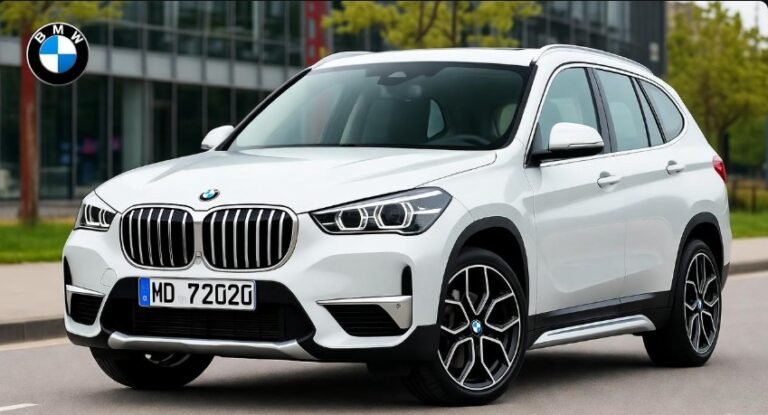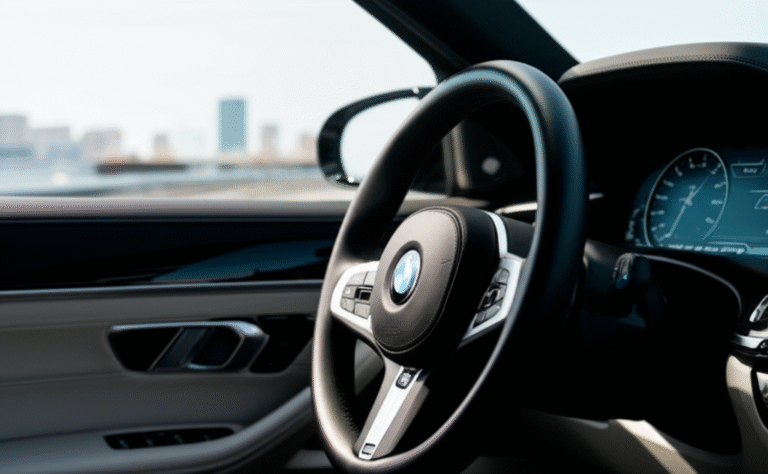BMW 7 Series Ground Clearance: 7 Insights

Your BMW 7 Series ground clearance is crucial for navigating varied American terrains safely, especially with its luxury focus. Understanding its capabilities prevents costly damage and ensures a smooth ride.
In This Article
- 1 Key Takeaways
- 2 What is BMW 7 Series Ground Clearance?
- 3 BMW 7 Series Ground Clearance: A Closer Look at Different Generations
- 4 How BMW 7 Series Ground Clearance Impacts Your Drive
- 5 Understanding Adjustable Suspension Systems in the BMW 7 Series
- 6 Practical Insights: Protecting Your BMW 7 Series from Road Hazards
- 7 7. Maintaining Optimal Tire Pressure
- 8 BMW 7 Series Ground Clearance: A Summary of Insights
- 9 Frequently Asked Questions about BMW 7 Series Ground Clearance
- 9.1 Q1: What is the typical ground clearance of a BMW 7 Series?
- 9.2 Q2: Can I increase the ground clearance of my BMW 7 Series?
- 9.3 Q3: Will driving my BMW 7 Series through snow cause damage?
- 9.4 Q4: How do I know if my BMW 7 Series has adjustable air suspension?
- 9.5 Q5: What is the risk of damaging my BMW 7 Series’ undercarriage?
- 9.6 Q6: Is ground clearance important for highway driving?
- 9.7 Q7: Where can I find the exact ground clearance for my specific BMW 7 Series model?
- 10 Conclusion
Key Takeaways
- Understand BMW 7 Series ground clearance basics.
- Discover how its clearance affects driving.
- Learn about adjustable suspension systems.
- Identify scenarios where clearance matters most.
- Explore ways to protect your luxury sedan.
- Prepare for varied road conditions in the USA.
When you think of a BMW 7 Series, you likely picture a pinnacle of luxury and performance on the open road. You might wonder about its practical side, especially concerning the ground clearance. This figure is more than just a number; it’s a key factor in how your vehicle interacts with the world around it. In the diverse driving landscapes of the USA, from urban streets with speed bumps to rural roads with uneven surfaces, knowing your BMW 7 Series ground clearance is essential. It ensures you avoid scraping the undercarriage, protect vital components, and maintain the smooth, comfortable ride that defines this prestigious sedan. This guide will break down everything you need to know about your BMW 7 Series ground clearance, making it clear and easy to understand.
What is BMW 7 Series Ground Clearance?
Ground clearance, also known as ride height, is the shortest distance between the lowest point of the vehicle’s chassis and the surface it’s traveling on. For the BMW 7 Series, this measurement is particularly important because it’s a luxury flagship sedan designed for supreme comfort and sophisticated handling. While not intended for off-roading, its ground clearance is engineered to provide a comfortable ride over typical road surfaces found across the United States. It plays a critical role in determining what obstacles your car can clear without damage.
The specific ground clearance for a BMW 7 Series can vary slightly depending on the model year, trim level, and whether it’s equipped with standard suspension or an optional adaptive or air suspension system. Generally, luxury sedans like the 7 Series are designed with a moderate ground clearance to balance aerodynamic efficiency, a low center of gravity for stability, and the ability to handle everyday road imperfections. Understanding this measurement helps you make informed decisions about where you can drive and how to approach potential hazards.
BMW 7 Series Ground Clearance: A Closer Look at Different Generations
The BMW 7 Series has evolved significantly over its many generations, and so has its design, including how it sits on the road. While exact figures can fluctuate, understanding the general trends provides valuable insight. Each generation aims to balance the brand’s sporting heritage with the increasing demands for comfort and advanced technology expected in a flagship luxury sedan.
For instance, older generations might have had slightly different clearance profiles compared to the latest models, which often incorporate more sophisticated suspension technologies that can adapt to driving conditions. It’s always best to consult your owner’s manual or BMW’s official specifications for the most precise ground clearance for your specific model year.
Recent Models and Their Ground Clearance
In more recent generations, such as the G11/G12 (2015-2022) and the current G70 (2022-present), BMW has increasingly focused on offering advanced suspension options. Many 7 Series models come equipped with adaptive suspension or air suspension as standard or optional features. This technology allows the vehicle’s ride height to be adjusted, either automatically based on driving conditions and speed, or manually by the driver.
For example, the standard ground clearance for many of these models hovers around 5.0 to 5.5 inches (approximately 12.7 to 14 cm). However, with the air suspension activated, this can be increased by a few inches, providing crucial extra clearance when needed. This adaptability is a significant benefit for drivers in areas with challenging road conditions.
Table 1: Approximate Ground Clearance for Recent BMW 7 Series Generations
| Model Generation | Approximate Standard Ground Clearance (inches) | Approximate Standard Ground Clearance (cm) | Notes on Adjustable Suspension |
|---|---|---|---|
| G11/G12 (2015-2022) | 5.0 – 5.3 | 12.7 – 13.5 | Optional/Standard air suspension could increase height. |
| G70 (2022-Present) | 5.2 – 5.5 | 13.2 – 14.0 | Standard air suspension typically offers height adjustment. |
How BMW 7 Series Ground Clearance Impacts Your Drive
The ground clearance of your BMW 7 Series has several direct impacts on your driving experience and the longevity of your vehicle. It’s not just about avoiding scrapes; it influences handling, comfort, and even your ability to traverse certain terrains.
One of the most common challenges for any car, especially a lower-slung luxury sedan, is navigating speed bumps and angled driveways. A lower ground clearance means you need to approach these obstacles at an angle and often at a reduced speed to prevent the front bumper, underbody panels, or exhaust system from making contact with the ground. For the 7 Series, especially in urban environments like those found across the USA, this is a daily consideration.
If your 7 Series is equipped with adjustable air suspension, you can often raise the vehicle’s height to clear these obstacles more comfortably. This feature is invaluable for residents of areas with numerous speed bumps or for accessing parking garages with steep entry ramps. Without this adjustment, drivers must be extra vigilant, a task that can detract from the effortless luxury experience.
2. Road Imperfections and Uneven Surfaces
Beyond intentional obstacles, the roads themselves can present challenges. Potholes, uneven pavement, and construction zones are common sights across America. Your BMW 7 Series’ ground clearance determines how well it can absorb these imperfections without subjecting its occupants to jarring impacts or risking damage to suspension components, wheels, or tires. A slightly higher clearance, or an adaptive suspension that can react quickly, helps to smooth out these rough patches, maintaining the car’s renowned ride quality.
3. Aerodynamics and Stability
Vehicle manufacturers carefully balance ground clearance with aerodynamics. A lower ride height generally contributes to better aerodynamic efficiency, reducing drag and improving fuel economy. It also lowers the car’s center of gravity, which enhances stability, particularly at higher speeds and during cornering – a hallmark of BMW’s driving dynamics. However, this often means a trade-off with the ability to clear obstacles. Modern luxury sedans like the 7 Series employ sophisticated engineering to achieve a balance, often using active aerodynamic elements and adaptive suspension systems.
4. All-Weather Performance and Light Snow
While the BMW 7 Series is not an off-road vehicle, its ground clearance does play a role in its ability to handle light snow or driving through puddles. In areas that experience moderate snowfall, such as the Northeast or Midwest during winter, a lower ground clearance can make driving difficult once snow accumulates on roads. If your 7 Series doesn’t have adjustable height, you might need to limit travel during or after snowfall. Drivers in such regions often opt for winter tires and may consider the AWD (xDrive) variants for better traction, but ground clearance remains a limiting factor in deep snow.
For more information on how BMW’s xDrive all-wheel-drive system enhances performance in various conditions, you can explore resources like the official BMW USA website.
Understanding Adjustable Suspension Systems in the BMW 7 Series
One of the most significant advancements in luxury vehicles, including the BMW 7 Series, is the integration of adjustable suspension systems. These technologies are designed to enhance both ride comfort and dynamic performance, offering drivers greater control and adaptability.
Air Suspension: The Game Changer
Many BMW 7 Series models come equipped with air suspension. This system replaces traditional coil springs with air springs – essentially durable rubber bellows filled with compressed air. The air compressor and control unit regulate the air pressure within these springs to:
- Adjust ride height: Drivers can often select different ride height settings, typically via a button in the cabin or through the infotainment system. This allows you to raise the car for clearing obstacles or lower it for improved aerodynamics and a sportier feel.
- Maintain a level ride: The system automatically adjusts to keep the car level, even when carrying heavy loads or towing.
- Adapt damping: Paired with adaptive dampers, the air suspension can dynamically adjust the stiffness of the suspension in real-time, responding to road conditions and driving inputs.
The benefit of air suspension for ground clearance is substantial. It provides a buffer against unexpected road hazards without compromising the car’s sophisticated handling characteristics during normal driving. For example, when approaching a steep driveway, you might select the highest setting to ensure clearance. Once on a smooth highway, the system can lower the car slightly for optimal aerodynamics and stability.
Adaptive Suspension Professional
Beyond air suspension, BMW often equips the 7 Series with sophisticated adaptive suspension systems. These systems monitor driving conditions and driver inputs (like steering and braking) to continuously adjust the damping characteristics of the shock absorbers. While not directly changing the static ground clearance, they significantly influence how the car reacts to uneven surfaces, making the ride smoother and more controlled. When combined with air suspension, these systems offer the ultimate in ride comfort and dynamic capability.
Practical Insights: Protecting Your BMW 7 Series from Road Hazards
Even with advanced suspension systems, vigilance is key to protecting your BMW 7 Series. Here are some practical tips to help you maintain its pristine condition and avoid costly damage:
5. When to Use the Adjustable Ride Height
If your 7 Series has adjustable air suspension, make it a habit to use the “raise vehicle” function when anticipating potential clearance issues. This includes:
- Approaching steep driveways, especially at home or at destinations.
- Navigating over large speed bumps or uneven surfaces.
- Entering or exiting parking garages with significant inclines.
- Driving through areas with known road construction or debris.
Be aware of the speed limitations when the vehicle is in its raised setting. Most systems recommend driving at lower speeds when elevated for maximum stability. Always consult your owner’s manual for specific instructions. Resources from the National Highway Traffic Safety Administration (NHTSA) also offer general advice on vehicle safety and maintenance best practices.
6. Approach Angles Matter
Whether your car has adjustable suspension or not, the angle at which you approach any obstacle is critical. Instead of hitting a speed bump or driveway incline head-on (a perpendicular approach), try to angle your approach. This allows the wheels on one side of the car to clear the obstacle before the other, distributing the stress and reducing the likelihood of scraping the undercarriage or scraping the front bumper.
7. Be Mindful of Parking
When parking, be conscious of curbs, especially in parallel parking situations. Many curbs in the USA are higher than you might expect. Also, be aware of parking stoppers or concrete barriers in parking lots, which can be surprisingly unforgiving. Always leave a safe margin between your car and any potential hazards.
7. Maintaining Optimal Tire Pressure
While not directly related to ground clearance, maintaining the correct tire pressure is crucial for overall vehicle health and can indirectly influence how your car handles bumps and uneven surfaces. Properly inflated tires contribute to a smoother ride and help absorb minor road imperfections more effectively. Over or under-inflated tires can lead to a harsher ride and increased wear on suspension components. Check your vehicle’s recommended tire pressure, typically found on a sticker in the driver’s side doorjamb or in your owner’s manual.
For detailed information on tire maintenance and safety, the U.S. Tire Manufacturers Association (USTMA) is an excellent resource.
BMW 7 Series Ground Clearance: A Summary of Insights
To recap, understanding your BMW 7 Series ground clearance is essential for preserving its luxury status and ensuring a smooth driving experience across the varied American landscape. Here’s a breakdown of the key insights:
Table 2: Key Insights on BMW 7 Series Ground Clearance
| Insight Number | Key Aspect | Practical Implication | Relevance to USA Driving |
|---|---|---|---|
| 1 | Standard Clearance Range | Determines basic obstacle negotiation capability. | Crucial for urban environments with speed bumps, varied road quality. |
| 2 | Adjustable Air Suspension | Offers variable ride height for enhanced clearance or sportier drive. | Invaluable for diverse terrain and navigating common US road challenges. |
| 3 | Impact on Handling & Aerodynamics | Lower clearance can improve stability and efficiency, but increases scrape risk. | A sophisticated balance actively managed by modern 7 Series technology. |
| 4 | All-Weather Considerations | Limited ability in deep snow or off-road conditions due to height. | Drivers in snowy regions need to be mindful, especially without AWD. |
| 5 | Protective Driving Techniques | Using raised suspension, angled approaches, and mindful parking prevent damage. | Essential for maintaining a luxury vehicle’s condition in the USA. |
| 6 | Tire Pressure Importance | Correct pressure optimizes ride comfort and suspension longevity. | A fundamental aspect of car care applicable everywhere in the US. |
| 7 | Consulting Owner’s Manual | Provides definitive specs and operational guidance for your model. | The most reliable source for your specific BMW 7 Series. |
Frequently Asked Questions about BMW 7 Series Ground Clearance
Q1: What is the typical ground clearance of a BMW 7 Series?
The typical standard ground clearance for recent BMW 7 Series models ranges from approximately 5.0 to 5.5 inches (12.7 to 14 cm). However, this can be increased significantly if the vehicle is equipped with an adjustable air suspension system.
Q2: Can I increase the ground clearance of my BMW 7 Series?
If your 7 Series is equipped with air suspension, you can usually raise the vehicle’s ride height through the car’s settings. For models without adjustable suspension, increasing the ground clearance is generally not feasible without significant and costly modifications, which could also void warranties and affect handling.
Q3: Will driving my BMW 7 Series through snow cause damage?
Driving through light snow is generally fine, especially if your vehicle has xDrive all-wheel drive. However, deep snow can easily exceed the ground clearance, leading to the car getting stuck or the undercarriage scraping, which can cause damage to the body panels, exhaust system, or other components. Always assess snow depth before driving.
Q4: How do I know if my BMW 7 Series has adjustable air suspension?
You can usually determine if your 7 Series has adjustable air suspension by checking your vehicle’s specifications, looking for suspension controls within the iDrive system or on the dashboard, or by consulting your owner’s manual. Often, there will be an indicator light on the suspension control button.
Q5: What is the risk of damaging my BMW 7 Series’ undercarriage?
The primary risk comes from driving over obstacles that are higher than the vehicle’s ground clearance. This includes steep driveways, large speed bumps, rough terrain, or when parking too close to curbs or parking barriers. Using the adjustable ride height and employing careful driving techniques can mitigate this risk.
Q6: Is ground clearance important for highway driving?
While ground clearance is more critical for navigating obstacles on the road, a lower ride height generally contributes to better stability and aerodynamic efficiency at highway speeds. If your car’s air suspension lowers itself at speed, this is an intentional design to improve performance.
Q7: Where can I find the exact ground clearance for my specific BMW 7 Series model?
The most accurate information regarding the ground clearance for your specific BMW 7 Series model year and trim will be found in your vehicle’s owner’s manual. You can also often find detailed specifications on the official BMW USA website or by contacting a BMW dealership.
Conclusion
Your BMW 7 Series is a masterpiece of automotive engineering, designed to deliver unparalleled luxury and driving pleasure. Understanding its ground clearance is a vital part of maintaining that experience. Whether you’re navigating the bustling streets of New York City, the scenic routes of California, or encountering the seasonal challenges of the Midwest, this knowledge empowers you. By appreciating how ground clearance affects your drive, utilizing features like adjustable air suspension, and practicing mindful driving habits, you can ensure your 7 Series remains in pristine condition, ready to offer its signature comfort and performance for years to come. Drive confidently, knowing you’re equipped with the insights to protect your investment and enjoy every journey.






